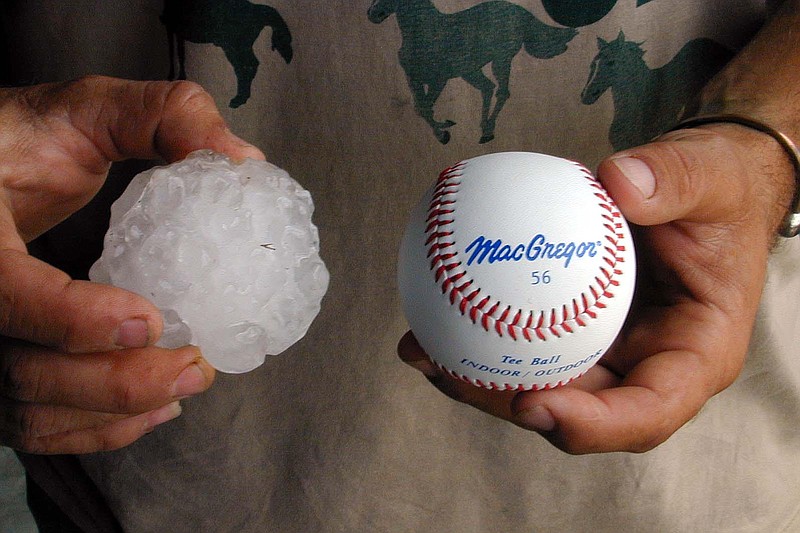Although spring storms leave quite an impression on the Arkansas imagination, the National Weather Service reports that the state typically experiences a secondary severe weather season in the fall or early winter — two years out of every three.
In 2001, 2002, 2004, 2005 and 2014, tornadoes were most prevalent across the state in the fall. Tornadoes commonly come from supercell storms: storms with updrafts of rising air that slowly rotate. But only 20% of supercell storms create tornadoes.
More commonly, supercell thunderstorms create high winds — and hailstones.
When hail falls and Arkansans want to tell their social media world about it, these are the terms recommended by the National Weather Service:
1/4 inch: pea
1/2 inch: small marble
3/4 inch: penny
7/8 inch: nickel
1 inch: quarter
1 1/4 inch: half dollar
1 1/2 inch: pingpong ball
1 3/4 inch: golf ball
2 inches: lime or hen egg
2 1/2 inches: tennis ball
2 3/4 inches: baseball
3 inches: large apple
4 inches: softball
4 1/2 inches: grapefruit
4 3/4-5 inches: CD/DVD
The record for large hailstones found in Arkansas since 1980 is 5 inches in diameter — slightly larger than a DVD.
Dennis Cavanaugh, the National Weather Service warning coordination meteorologist at Little Rock, says three documented hailstones share the record. They fell:
◼️ May 4, 2020, in Johnson (Washington County)
◼️ April 2, 2006, 2 miles north of Searcy (White County)
◼️ Jan. 21, 1999, in Newark (Independence County).
Big as they were, they fell short of the largest officially recognized record hailstone in the United States. It fell near Vivian, S.D., on July 23, 2010. Its longest diameter was 8 inches.
On June 19, 2019, grapefruit-size hail estimated to be 5 inches fell at Vandervoort in rural Pike County. One clobbered Justin Bond's mother's car windshield. Bond posted a photo of a knobby, asymmetrical hailstone on Twitter (see arkansasonline.com/912bond).
"A research group was very interested in the hailstone and sent out a team with sophisticated 3D laser scanners and a scale (for weight)," Cavanaugh wrote in an email. These were researchers from the Insurance Institute for Business & Home Safety's IBHS Hail Study (on Twitter @IBHSHailStudy).
"The 'record largest hail' in the United States was measured at 8 inches, but hail is measured by its longest diameter, not its weight," Cavanaugh wrote. "From what we can tell, despite the fact that the research team found the Vandervoort hailstone falling just short of the state record hail size (it measured 4.6 inches in diameter), it actually weighed a bit more than the Vivian, S.D., 8-inch hailstone.
"The Vivian hailstone must have been much longer than its width, cutting down on its weight."
Baseball-size hail has been observed in Arkansas at least once a year since 1980, with the exception of 2005 and 2013.
According to an agency roundup of Arkansas weather statistics, so far in 2022 there was 4.5 inch hail at New Blaine in Logan County on April 11; and during storms April 15, 4.25-inch hail fell at Cherokee Village in Sharp County and 4-inch hail fell west of Viola in Fulton County and at Lake City in Craighead County (see weather.gov/media/lzk/StormsOf2022.pdf).
Insurance claims for damage from large hailstones have risen, according a recent report in The New York Times. A risk assessment firm, Verisk, said claims on cars, houses and crops damaged by hail hit a record $16.5 billion in 2021. Although fatal strikes are very rare, in recent years hailstorms have killed zoo animals in Colorado and a toddler in Spain.
A meteorologist with the Insurance Institute for Business & Home Safety told the Times that damage from very large hail is worsening.
The institute has one of the nation's few research programs devoted to figuring out why. Among working theories are effects of climate change, increased reporting and that a burgeoning human population is sprawling into areas were supercell storms are most likely to form.
